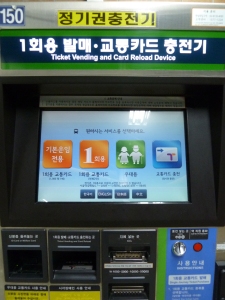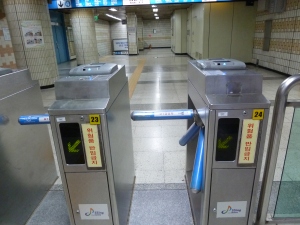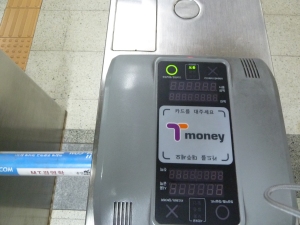How to get a ticket for the subway in Korea – photo guide
New systems can often be confusing. Coming from London, England: home of the world’s very first network of underground railways and stations is now outdated. Korea’s system is new, spacious, modern. As such it is actually more user-friendly. Once you have worked out where you want to go on the subway map, you need to buy a ticket.
In the lobby, there will be a bank of ticket machines and deposit refund devices. First you needn’t worry about the latter. The ticket issuing is in 4 languages (Korean, English, Japanese and Chinese). It is all done by touch screen.
First select the language.
Then select the station you wish to go to. This is alphabetized.
Choose you station, then you will be asked how many tickets you wish to buy. Select the number and insert your money.
The money-eating mouth hole of the machine will light up green to indicate where to feed it.
A few seconds later, you ticket will be spat out, again in a little compartment which will light up.
The cards work much like the oyster of London or octopus cards of Hong Kong. Just touch it to the pad as you walk through the gate, both on your way in and out.
Once your journey is complete, head to the bank of ticket machines in your destination station and find the deposit refund device. Insert your card and you will get a little money back.
The T-Money travel card is only worth buying if you are going to use the transport system more than 20 times. This is the point where you will start to save money from the purchase price of the T-Money card.
Navigating the subway system in Seoul
Seoul’s subway system has sprouted 3 new lines from the time I arrived at the end of 2009, to present (mid 2011). Building is still underway, so that by 2013, there should be extensions to the current lines 3 and 9 (orange and gold).
Earlier in 2011, the full length of the airport railroad was finally opened, starting at Seoul station, which along with overland trains to all areas in South Korea, also connects subway lines 1 and 4 (dark and light blue). It travels through some major tourist areas such as Hongik University (Hongdae area), and also connects Gimpo Airport, before terminating at Incheon Airport. Riding the full length, including and transfers prior to entering the airport railroad (provided you complete your transfer within 30 minutes) should cost roughly W5000 ($5). See T-Money card for more information.
Line 2 (green) is the circular line, traversing central Seoul.
Line 3 (orange) runs from the north west to the south east, Line 4 (blue) from north to south, Line 5 (purple) from east to west, Line 6 (brown) from north west, through the centre, but keeping north of the river, to the north east, Line 7 (dark green) from north east to south west, Line 8 (pink) is confined to the south east and Line 9 (gold) from east to west keeping south of the river.
There are other lines that head outside the city or deal with the extremities of the conurbation which I will detail in a different post.
Using the subway system could not be simpler. Look for the touch screen machines by the entry gates inside the subway station. There are options in English, Japanese and Chinese, as well as Korean. For single travel, prices start from W1500 ($1.5), although W500 of the fare is a deposit for the orange travel ticket you will receive.
After completing your journey and exiting the gate in your destination station, look for the ‘Deposit Refund Device’ machine, insert the orange ticket, and it will spit out W500 for you. These are usually situated next to the ticketing machines and are clearly labelled.
The general rule for the fare is any journey under 10km is W1000, then you pay a little extra, usually W100 per additional 5km. Bus fares are similarly priced.
If you are staying in Seoul for a week or more, you might consider buying a T-Money card, as you will likely save money using it on public transportation, however you probably need to make about 20 individual journeys before you start to save money.
The airport railroad
Early in 2011, the airport railroad opened up, connecting Incheon Airport with Gimpo Airport, the hongdae area and ending at Seoul Station, which in turn connects Seoul to the rest of the country. Look for signs in the airport pointing out the airport railroad or ask for directions at the numerous information kiosks.
Riding the full length, including and transfers prior to entering the airport railroad (provided you complete your transfer within 30 minutes) should cost roughly W5000 ($5). This means you will end up paying about half the price of a bus ticket. See T-Money card for more information.
If you are taking the Airport Railroad from the city centre to the airports, then yu can board at Seoul Station, which also links to Lines 1 & 4 of the subway. The entrance is well posted and is found close to Platforms 12 and 13 in Seoul Station.
It can also be boarded from various other stations in Seoul. See map for more information.










